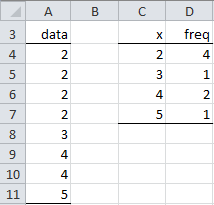
Frequency Distribution Table Generator. How often 1 occurs 2 times how often 2 occurs 5 times etc and wrote them down as a Frequency Distribution table. Each of the entries that are made in the table are based on the count or frequency of occurrences. This will bring up the Frequencies dialog box. How to use the calculator.
The calculator will also spit out a number of other descriptors of your data - mean median skewness and so on. Frequency distribution can be defined as the list graph or table that is able to display frequency of the different outcomes that are a part of the sample. Frequency Table Calculator A frequency table corresponds to an organized table that contains the different values that are in the sample along with the frequencies of those values how many times each value appears in the sample. Enter the details of the required number of intervals and click on the Calculate button. To start just enter your data into the textbox below either one value per line. Males Scores Frequency 30 - 39 1 40 - 49 3 50 - 59 5 60 - 69 9 70 - 79 6 80 - 89 10 90 - 99 8 Relative Frequency Distribution.
The frequency table calculator will automatically calculate the frequencies and update you with the table.
This Frequency Distribution Calculator is intended for calculation of the number of times a data value occurs in a given data set. I have created an ASP Page to display the table based on the date ranges selected. Enter the data values separated by commas line breaks or spaces. The frequency table calculator will automatically calculate the frequencies and update you with the table. For the class 150-159 the lower class limit is 150 and the upper-class limit is 159. The most common and straight forward method of generating a frequency table in R is through the use of the table function.
